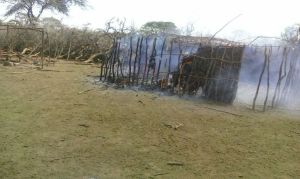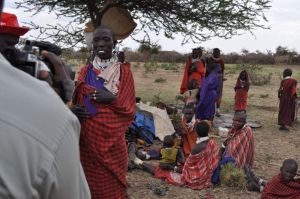Press Release 17 February 2015
Please find the PDF Version of this press release here.
Follow the case on this webpage.
The ICCA Consortium, Geneva (Switzerland)
Earlier this week the ICCA Consortium received notification through various networks and members of an operation carried out by Serengeti National Park against the Maasai residents of villages bordering the park in the villages of Ololosokwan and Arash in Loliondo. As reported in the Tanzanian media,[i] this incident involved the destruction of over 100 homesteads, as well as food and other family supplies, the confiscation of livestock, and alleged violence committed against members of the community. The Serengeti National Park Chief Warden is quoted in media reports as justifying the situation as follows: “We are protecting the park; these pastoralists have been bringing large groups of livestock to graze inside the park. We are clearing them out.”
It should be noted that this destruction of property is reported to be taking place outside the park boundaries on community lands. These are the same community lands in Loliondo that have been the subject of recurrent conflicts between government agencies and local community members, including past destruction of property and alleged human rights abuses that took place in 2009. In 2013, this same area was the subject of local, national and international controversy when the government proposed converting the entire area into a Game Reserve and evicting up to 25,000 people. [ii] As this week’s reports indicate, Loliondo and the greater Serengeti area continue to be the focus of conflicts between the government and local community members over land use and conservation policy.
The conflicts just reported in Loliondo are the latest acute incident of a chronic tension between government conservation policies and enforcement measures and local communities in Tanzania. The villagers of Uvinje, on the border of Saadani National Park, have been fighting eviction for 14 years,[iii] despite having played a central role in the creation of the park, spontaneously offering to conservation the land they rightfully owned. In the Ngorongoro Conservation Area, more than 60,000 people recently faced famine due to restrictions on land and resource use in the region of the World Heritage Site even during an exceptional drought period.[iv] Other areas where similar controversies have surfaced in recent years include Kimotorok village, adjacent to Tarangire National Park, the Kilombero Valley, and the Usangu wetlands now enclosed in Ruaha National Park.
Tanzania has long been known as a global leader in conservation, with more than a quarter of its total land area set aside as national parks and other protected areas. But the country has also been the site of conflicts between government agencies, private investors, and local communities, and it is clear from these events that these conflicts are worsening. These conflicts have critical implications for the country’s conservation results and national income, as the tourism industry, built upon Tanzania’s wildlife areas, generates nearly $2 billion in annual revenue.
The critical issue is that Tanzania’s recent pattern of forceful eviction, confrontation and destruction of property of community members living adjacent to protected areas, works counter to the objectives of its own conservation policies and national interests, as well as contravening international human rights standards and conservation instruments. In November 2014, more than 6,000 people from countries around the world, including Tanzanian government officials,gathered at the World Parks Congress in Sydney, Australia, to identify key strategies and actions for conservation over the next decade. The resulting Promise of Sydney,[v] the key document produced by this global gathering, highlights the central importance of local communities and indigenous peoples in conservation:
We will motivate and engage a new generation of urban and rural communities as an essential investment in the future of sustainability on the planet, and in the quality of life of people everywhere. Further, by working in partnership with and recognizing the long traditions and knowledge, collective rights and responsibilities of Indigenous Peoples and local communities to land, water, natural resource and culture, we will seek to redress and remedy past and continuing injustices in accord with international agreements.

This statement builds on more than 20 years of evolving conservation policy under the Convention on Biological Diversity and by the International Union for the Conservation of Nature (IUCN), which have worked to align conservation with international human rights standards and to foster greater partnership with local communities and indigenous peoples. All of this is born from the recognition of two crucial facts. The first is that nature conservation cannot be sustainably maintained if it fails to gain the support of the peoples living alongside wildlife, forests and nature in general. The second is that indigenous peoples and local communities, properly recognised in their collective rights and supported to enforce local and customary rules and secure livelihoods, can be the most effective actors in conservation.
Tanzania itself is emblematic of these facts. On the one hand, no fewer than 1,233 villages have brought 2.366 million hectares of woodland and forest and comparable natural flora areas under protection as village owned and managed reserves. A further 5.392 million hectares of National and Local Authority Reserves are managed by communities under the technical guidance of local and national forest authorities.[vi] And more than 3% of the country’s land area is under 38 Wildlife Management Areas— communal lands set aside by 148 villages exclusively as habitat for wildlife, engaging active contributions to conservation by more than 440,000 people.[vii] On the other hand, and readily picked up by prestigious international media,[viii] the country faces a poaching crisis. Perhaps 50% of its elephants have been lost in the past five years, and both government and private investors are deeply concerned about the impact wildlife killing will have on the critical tourism industry. It is widely recognized, in Tanzania’s own official policy and in a range of new internationally-funded conservation initiatives, that stemming the loss of elephants and other wildlife requires enlisting communities in the fight against poaching. Sharing revenues from wildlife inside and outside protected areas and involving communities in conservation is critical to this. Evicting rightful landowners and burning down the homes of communities living next door to one of the most famous national parks in the world is flagrantly counter-productive to such aims and interests.
For its own economic interests in tourism, for the human rights and wellbeing of its people, and for the sustainability of its extraordinary wildlife and other biological riches, Tanzania needs to address the recurrent sources of conflict pitting conservation against indigenous and local communities. It has the choice of engaging with policies and practices that respect both, effectively and coherently.
The ICCA Consortium, Geneva, Switzerland 16 February, 2015
The ICCA Consortium is a Swiss-based international association dedicated to promoting the appropriate recognition of, and support to, the territories and areas conserved by indigenous peoples and local communities (ICCAs).
Contacts:
Dr. M. Taghi Farvar, President taghi@cenesta.org
Dr. Grazia Borrini-Feyerabend, Global Coordinator gbf@iccaconsortium.org
Ms. Sarah Ryder, Programme Manager sarah@iccaconsortium.org
Notes:
[i] http://www.ippmedia.com/frontend/index.php?l=77398
[ii] http://www.aljazeera.com/video/africa/2013/04/20134309749467675
[iii] http://www.iccaconsortium.org/?page_id=1704
[iv] http://www.minorityvoices.org/news.php/fr/1339/tanzania-pastoralists-face-famine-as-effects-of-drought-are-worsened-by-government-neglect
[v] http://worldparkscongress.org/about/promise_of_sydney_vision.html http://worldparkscongress.org/about/promise_of_sydney_vision.html
[vi] Ministry of Natural Resources and Tourism of Tanzania, Participatory Forest Management in Tanzania, Facts and Figures, Department of Policy and Planning of the Ministry of Natural Resources and Tourism, Dar es Salaam, 2012.
[vii] WWF, Tanzania’ s Wildlife Management Areas: A 201 2 Status Report , WWF, Dar es Salaam, 2014.
[viii] The economist, Big game poachers, http://www.economist.com/news/middle-east-and-africa/21631202-claims-links-between-politicians-and-poachers-merit-further-investigation-big




Reblogged this on Research for Change.
Pingback: Research for Change | Press Release